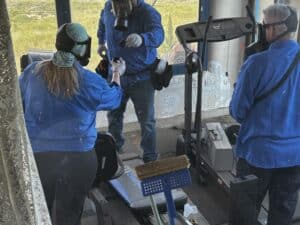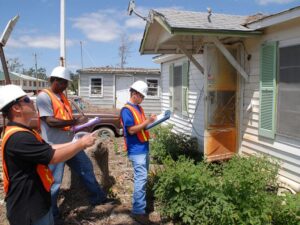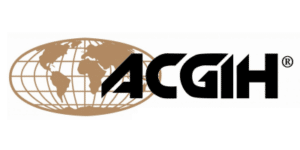Industrial Hygiene Experts Crack the Code for Workplace Safety
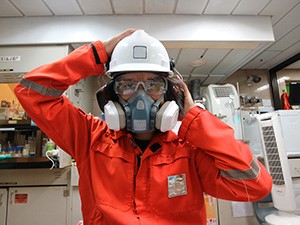
Kumar Gunaratna never really knows what he’s going to find when he walks into a job site, but he usually finds it.
As a senior industrial hygienist at Omega Environmental, it’s his job to root out the things that create unsafe or unhealthy conditions for workers and building occupants, no matter how well hidden or how convoluted the source.
It is a job that combines the observational skills of a detective with the diligence and patience of a scientist. “We hardly ever find the same things twice,” says Gunaratna. “We have to think outside the box all the time.”
When a woman in an office building complained of symptoms she believed were related to the air around her workspace, there was nothing immediately evident to explain why she would be the only one feeling ill – and only in the afternoon.
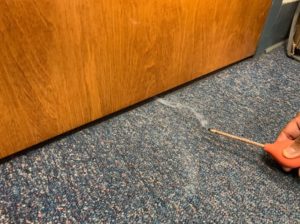
Gunaratna and the Omega team used a small device that produces a puff of non-irritant smoke to determine the direction of the air flow near her cubicle and discovered that the woman occupied the only part of the room that was negatively pressured. Gunaratna tracked the flow of air to an adjacent vacant office where, just as you might expect in a great detective story, the walls had been covered in code.
The answer, however, was not in the code – which software developers had scrawled on the walls with dry erase markers – but in their attempts to get it off, leaving dry erase cleaner liquid off-gassing in the afternoon sun.
Sometimes the work is less about solving a mystery and more about the collection and sampling of data.
Industrial Hygiene Assessments Keep Businesses Healthy and Compliant
An Industrial Hygiene Assessment helps businesses protect workers and reduce the risk and liability that unaddressed physical, chemical, and biological hazards in the environment can pose.
Some assessments are done for insurance purposes; others may be conducted in response to an OSHA complaint or as part of routine regulatory compliance requirements for a specific industry, like the annual personal monitoring required in the painting industry to monitor exposure to the compound hexavalent chromium.
Whatever the reason, an industrial hygiene assessment is an important investment in the health of your workers and the well-being of your business.
“The onus is on the employer to get this done,” Gunaratna says. “If it gets flagged … the employer could have legal exposure.”
Among the benefits of having an industrial hygiene assessment:
- Peace of mind that comes from a professional assessment and cost-effective solutions to quickly remedy any areas of concern.
- Employees’ confidence that their well-being is a priority and that their employers are committed to maintaining a safe working environment.
- Protection against fines and shutdowns that can follow violations from the Occupational Safety and Health Administration (OSHA) and Cal/OSHA.
Keeping Workers Safe and On the Job
In addition to personal sampling to determine whether exposure to various chemicals is within regulatory limits, industrial hygienists also test and monitor for hazards that include noise, light, ergonomics and other physical hazards including electrical and electromagnetic fields.
Indoor air assessments require personal sampling of about 15% of the workforce throughout an eight-hour shift. A filter housed in a cassette is pinned to a worker’s collar to sample the breathing zone. A pump placed on the belt with a hose attached allows environmental engineers to collect and analyze the air breathed by workers and compare exposure concentrations to the acceptable levels established by OSHA and guidelines provided by industry professional associations such as the American Conference of Governmental Industrial Hygienists.
Mitigation strategies for unsafe conditions can include:
- Engineering controls such as the use of wet methods to control dust, barrier construction to isolate a hazard, or ventilation which can include the use of regular fans to push more air into the building or exhaust fans to take contaminated air away. Both serve to dilute the concentration of dust, chemicals or other harmful substances in the air.
- Administrative controls including worker training, access restriction, and rotating shifts to limit the amount of time employees are exposed to a particular high-exposure task.
- Personal protective equipment such as the use of respirators, eye protection, gloves, and coveralls.
Expert Help for Managing Hazards
At Omega Environmental, we have decades of experience in providing industrial hygiene assessments for a range of industries and businesses including hospitals, universities, industrial manufacturing plants, and office buildings.
Our team, including Certified Industrial Hygienists and renowned toxicologists, has decades of expertise in testing, assessment and remediation of a wide variety of workplace environmental health risks. Reliable and professional, and with the advantage of state-of-the-art equipment for a broad array of sensitive measurements and analysis, our industrial hygiene services let clients get back to work quickly, safely and with the confidence that comes from having an experienced environmental partner.
To learn more about the work we do for industrial hygiene and safety, give us a call or click on the link below.




